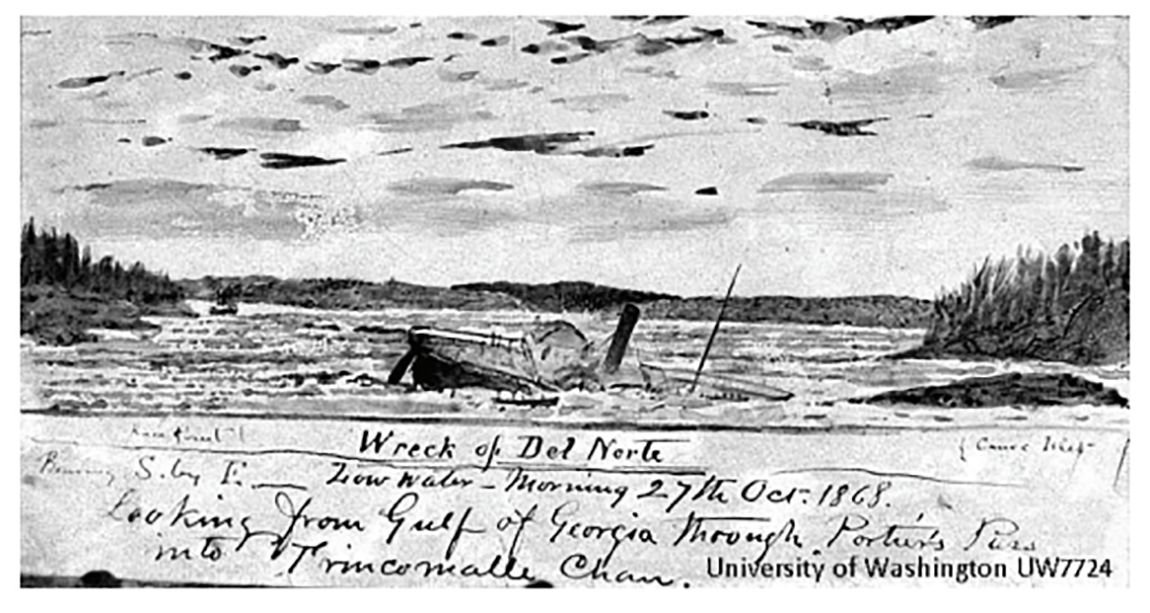Lost, but not forgotten - Shipwrecks Part 1 SS Del Norte

The Del Norte, launched in January 1865, built as a side paddle wheeler steamer and said to be the first ocean steamship of any significance built in the San Francisco shipyards. She was 190’ in length, with a beam of 45’ and hold depth of 7’.

The Del Norte was a cargo vessel mostly carrying supplies and ferrying passengers up and down the west coast of North America from San Francisco to Victoria on Vancouver Island and as far up the coast to Alaska. On October 22 on her way from Nanaimo BC loaded with passengers, luggage and cargo the captain made the decision to take a short cut through the treacherous waters of Porlier Pass. The channel was thought unsafe for sailing vessels, being narrow with shallow reefs and tidal streams running from 4‐9 knots, but the steamers were less cautious. On entering the pass, a thick fog convinced the Captain not to proceed further. Without enough room to turn about, the steamer attempted to back out of the pass. The paddle wheeler was caught in the flooding tide current, her stern grounding on Canoe Reef. Damage appeared minimal, with only her rudder displaced and a portion of her false keel torn away. The cargo, mostly coal was shifted forward lighten the stern and hopefully minimize the strain on the grounded ship however an early morning low tide increased the stress in her and she sheered to starboard on the reef. Water rushed in flooding the holds. Passengers, baggage, furniture, stores, and provisions were removed at daybreak. Attempts were made to salvage the vessel but to no success and on November 11 a southeast gale “lifted the steamer off the reef, and she settled in over ten fathoms of water”. The wreck was listed as a total loss, valued at $100,000 in gold. Gold was worth $18.93 per ounce in 1868, so her value today, in gold, would be about $8.95 million dollars.

Diving the Del Norte is a challenge for the same reasons she grounded; the tidal currents can be extreme, and the wreck must be dove at slack tide. The visibility in the area can be very pour at times as well, and I have cancelled several dives over the years due to how bad it was. Baring bad visibility and pour weather conditions, the Del Norte is fairly simple to locate and for the most part pieces of the ship are still visible, but disappearing. The boilers, having been perforated over the years by careless anchoring above the wreck and the engine, crankshaft and hubs of the paddle wheels are readily identifiable and remnants of the copper-clad hull lie on the sandy‐shell bottom.


Diving any shipwreck can be hazardous due weather and water conditions additional proper certification and equipment for wreck diving is a must for any diver. Go with a local guide that can not only show you the wreck but also the resent marine life and provide you with the best underwater experience.


until next time...
Random Act of Kindness..
Hi scottdphoto,
This post has been upvoted from me! :)
If you like what I'm doing please upvote this comment so I can continue to support accounts like yours.
https://steemit.com/@naeemahmed
please follow and vote me
Upvoted. I'll be resteeming this now :)
https://steemit.com/@naeemahmed
please follow and vote me
Great story.
https://steemit.com/@naeemahmed follow me and vote me
somebody follow me please
https://steemit.com/@naeemahmed
Please follow and vote me
Interesting post...history is interesting because they say History was written by the victors.
Congratulations, your post received one of the top 10 most powerful upvotes in the last 12 hours. You received an upvote from @kpine valued at 69.81 SBD, based on the pending payout at the time the data was extracted.
If you do not wish to receive these messages in future, reply with the word "stop".
Follow me and get back comments and vote
great....
https://steemit.com/@naeemahmed
please follow me and vote me
Awesome post! I love history and one of my biggest hobbies is metal detecting. I would love to dive an old shipwreck like that!
https://steemit.com/@rakib331332
Follow me friend